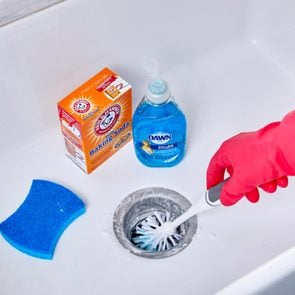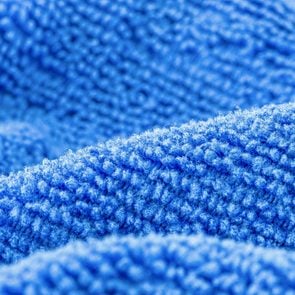How to Clean Your Kitchen Sponge So It’s Not Completely Gross
Updated: Apr. 18, 2024
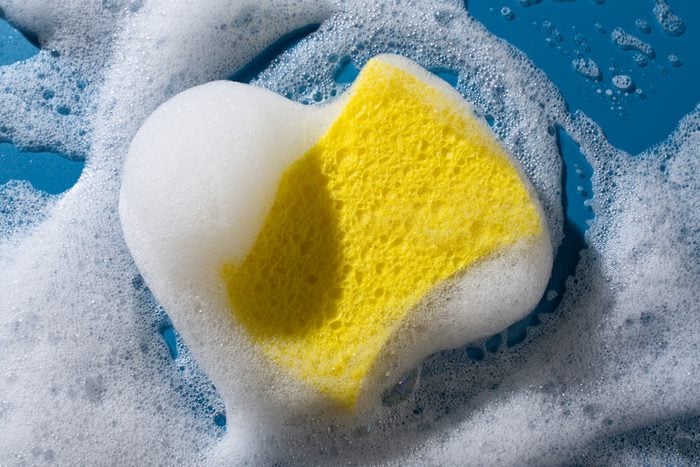
From quick microwave hacks to DIY cleaning solutions, here's how to clean a sponge the right way
Ah, the humble kitchen sponge—a silent hero in the war against dirty dishes and saucepans with stubborn stains. But if you’ve never considered how to clean a sponge itself, we have some bad news: It’s a hotbed for bacteria and germs. In fact, E. coli, Salmonella, Staphylococcus aureus and more can linger on a kitchen sponge for more than two weeks, according to the American Society for Microbiology.
“Sponges can be breeding grounds for bacteria,” says Brandon Pleshek, a third-generation janitor and the creator of the website and YouTube channel Clean That Up. “And they can spread germs across surfaces, leading to cross-contamination if not cleaned properly.”
Fortunately, sponges are easy to clean if you know the right methods, and you can avoid potential health issues if you clean them often enough. Reader’s Digest tapped two hands-on cleaning experts and a microbiologist to give you the 411 on sponge sanitation, exploring the why, how and when of keeping your kitchen sidekick germ-free.
Get Reader’s Digest’s Read Up newsletter for more cleaning, tech, travel, humor and fun facts all week long.
About the experts
Reviewed for accuracy by: Ann Russell, TikTok’s “cleaning auntie” and the author of How to Clean Everything. |
Why are kitchen sponges so dirty?
It’s ironic that a kitchen sponge, something whose entire purpose is to clean, can get so dirty. But the issue lies with the fact that they’re porous and often damp, as well as frequently come into contact with food waste. The holes throughout sponges are designed to trap both water and particles from food waste, a combo that bacteria love. When you wash dishes that have touched raw food products like chicken and hamburger meat, bacteria such as Salmonella and E. coli get trapped in the pores of the sponge. Then they multiply inside the sponge’s warm, moist environment. In fact, Duke University researchers found the average kitchen sponge has more bacterial species than a lab petri dish, including 80 different strains of E. coli.
And it gets worse. That lingering and continually multiplying bacteria can transfer to other surfaces that the sponge touches, like your countertops and dishes. “Every time you use a sponge, you are spreading bacteria around—and that’s a free ride for fecal bacteria [like E. coli],” says Charles Gerba, PhD, a professor of microbiology and public health at the University of Arizona.
How to clean a sponge
We’re guessing you’re really ready to clean your sponge after reading that. (We definitely are!) But there are a few different ways to do it effectively. Here’s what experts recommend to remove odors, eliminate illness-causing microorganisms and extend your sponge’s life.
How to clean a sponge in the washing machine
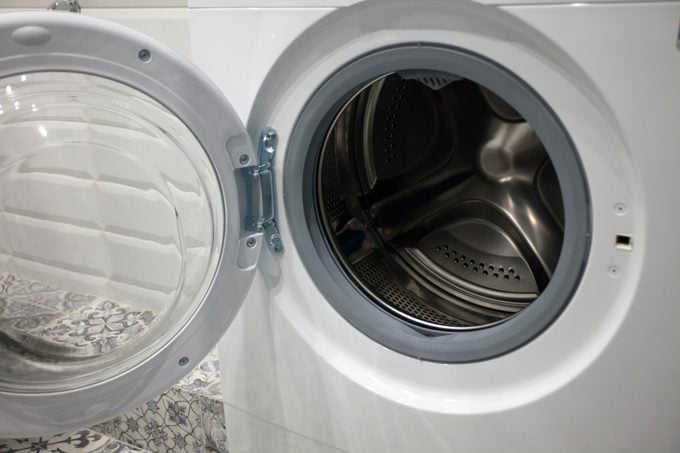
Using a washing machine is Pleshek’s preferred method for sanitizing his own sponges. But, he warns, make sure that the sponge is durable enough to be washed or it could fall apart. (Pleshek recommends Scrub Daddy sponges, which can withstand a spin in the washing machine.)
Supplies you’ll need
- Laundry detergent
- Washing machine
Directions
- Place the sponge in your washing machine, along with any other items you want to wash in hot water.
- Add 1 tablespoon of laundry detergent.
- Set your washing machine to its hottest setting—ideally, 140 degrees, which is the temperature needed to kill bacteria.
- When the washing cycle ends, remove the sponge, and wring it to remove excess water.
- Leave the sponge on a clean surface to dry.
Pro tip: While Pleshek opts for a bleach-based laundry detergent, you can also use whatever you have on hand, since the hot water will sanitize the sponge.
How to clean a sponge in the dishwasher
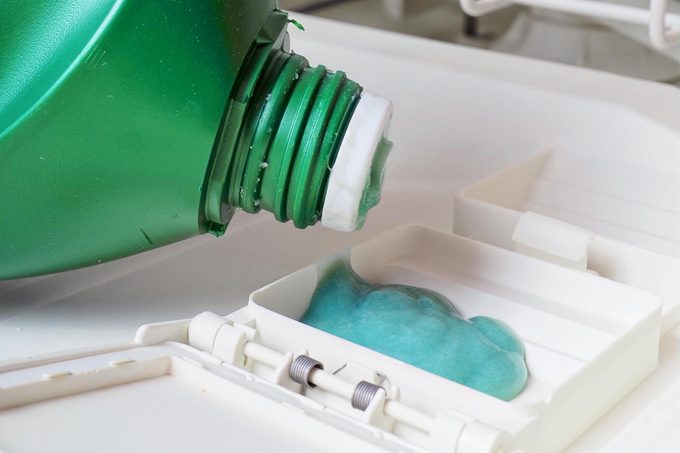
If you’re cleaning your sponge in a dishwasher, it’s essential to secure the sponge so that it doesn’t move around during the wash cycle. A loose sponge could clog the drain of the dishwasher, Gerba says. With that in mind, follow these steps for sanitizing your sponge in a dishwasher.
Supplies you’ll need
- Dishwashing detergent
- Dishwasher
Directions
- Place the sponge in your dishwasher, securing it inside the utensils holder or between a slot for plates.
- Add 1 tablespoon of dishwashing detergent to the machine.
- Select the longest washing cycle with the highest heat setting, then press “Start.”
- When the washing cycle ends, remove the sponge, and wring it to remove excess water.
- Leave the sponge on a clean surface to dry.
How to clean a sponge in the kitchen sink
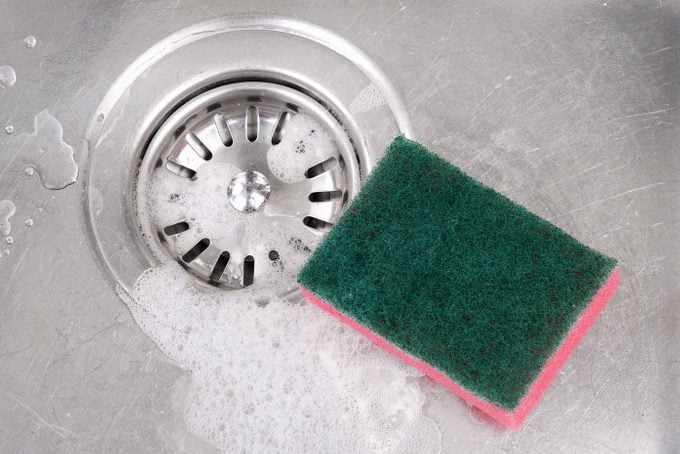
The kitchen-sink method is a little more labor-intensive, but the bleach will kill off any lingering viruses and bacteria. That’s one reason it’s the preferred way to clean sponges for Kristin DiNicolantonio, a senior director at the American Cleaning Institute. Just remember to handle the bleach with care to avoid getting it on your clothes or in your eyes.
Supplies you’ll need
- Chlorine bleach
- Water
Directions
- Fill your kitchen sink with 1 quart of room-temperature water and 3 tablespoons of chlorine bleach.
- Place the sponge in the mixture, and allow it to soak for five minutes.
- Remove the sponge, and wring it to remove excess water.
- Leave it on a clean surface to dry.
- Wash your hands after you’re finished. Bleach can ruin clothes and irritate your eyes and skin, so you’ll want to make sure to wash it off completely.
Important note: Use this method only with cellulose sponges (the ones that feel like cardboard and shrink slightly when dry). They are sturdy enough to withstand a bleach soak. However, bleach will destroy sponges made of lightweight plastic foam, so choose a gentler cleaning method for those.
How to clean a sponge in a small bowl or bucket
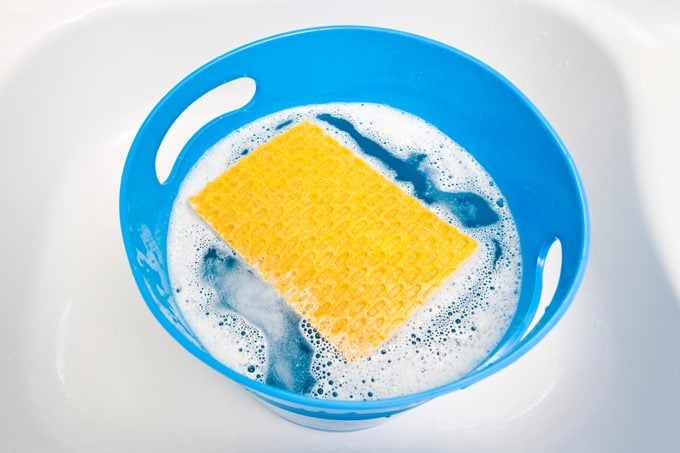
Gerba’s research has found that soaking a sponge in kitchen disinfectant cleaner that contains bleach is an effective way to sanitize it. You can also use vinegar as an all-natural alternative.
Supplies you’ll need
- Bucket or bowl
- Store-bought kitchen disinfectant, vinegar or boiling water
Directions
- Fill a bucket or bowl with enough vinegar, kitchen disinfectant cleaner or boiling water to cover the sponge. (Do not mix these products, and do not dilute the vinegar or disinfectant with water.)
- Place the sponge in the bucket or bowl, and allow it to soak for five minutes.
- Remove the sponge, and wring it to remove excess liquid.
- Leave it on a clean surface to dry.
How to clean a sponge in the microwave
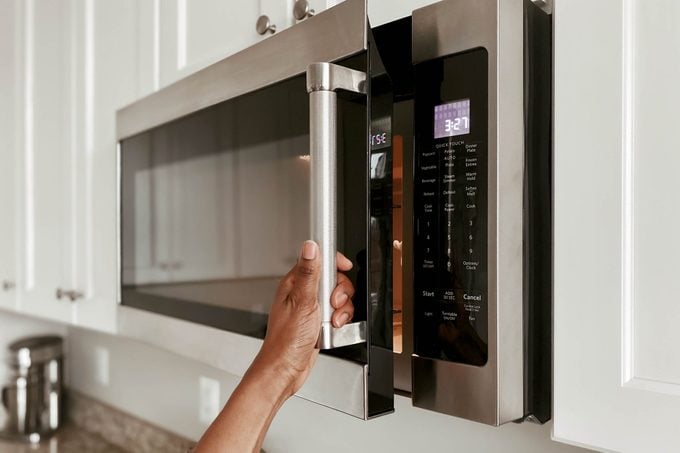
In a 2020 study published in the journal Microorganisms, sponges that were microwaved two to three times a week for at least one minute had significantly less bacteria than untreated sponges. One caveat: Most sponges are made with a polyester material that could ignite if it is dry and gets too hot, so make sure to stand nearby the microwave and monitor the sponge as it heats. You should also avoid using this method on sponges with metallic scrub pads, which can spark and catch fire in the microwave, Gerba says.
Supplies you’ll need
- Dish soap
- Hot water
- Microwave
Directions
- Lather a sponge with water and dish soap, then rinse it with hot water.
- Making certain that the sponge is still wet, put it in the microwave. Heat it on high for one to two minutes. Keeping the sponge wet is important, because a dry sponge could catch fire in the microwave.
- Remove the sponge, and wring it to remove excess water.
- Leave it on a clean surface to dry.
Cleaning vs. sanitizing a sponge: What’s the difference?
Keep in mind that cleaning a sponge doesn’t necessarily mean that you’ve sanitized it. Why? “Cleaning a sponge usually means removing visible dirt and debris, but it doesn’t necessarily kill bacteria,” Pleshek says. “Sanitizing involves using heat or chemicals to reduce bacteria.” In other words, rinsing the sponge with hot water and soap will clean it, but it takes a treatment with chemicals like bleach, extreme heat or a combination of both to kill bacteria on your sponge and properly sanitize it.
How often should you clean a kitchen sponge?
How often you clean your sponge will depend on how often you do dishes. Gerba says that a good benchmark to aim for is once every three to four days. If your sponge comes into contact with raw meat, however, Pleshek suggests washing it immediately, using one of the methods listed above. Not a frequent home cook? At the bare minimum, you should clean your sponge once a week, DiNicolantonio says.
When should you toss your sponge?
There is no hard-and-fast rule for replacing a sponge. But as a general guideline, heavily used sponges may need to be replaced every few weeks, while lightly used sponges may last a little longer, Pleshek says.
Use your eyeballs, nose and good, old-fashioned common sense too. If your sponge is coming apart or has a strong odor after cleaning, then you should toss it, says DiNicolantonio. Products that include sodium hypochlorite, such as Clorox Disinfecting Bleach or Lysol Multi-Purpose Cleaner with Bleach, can help deodorize sponges, but if the smell still lingers, then “it’s time to replace it,” Pleshek adds.
How can you keep your sponge as clean as possible?
Though getting your sponge dirty in the process of cleaning is inevitable, there are ways to extend the time between washes. DiNicolantonio recommends reserving your sponge for cleaning dishes and instead using a paper towel to mop up food spills, especially if there are juices from raw meat. Storing your sponge in a clean, dry area, such as a dish rack, will also help keep it clean longer, since leaving it in a damp environment will hasten the growth of germs. Keeping your kitchen clean will also go a long way toward minimizing the presence of bacteria.
Are there alternatives to a sponge?
Yes! Experts recommend using a cleaning brush or dish wand, which have bristles and handles that can be more easily cleaned and disinfected. In a 2022 study published in the Journal of Applied Microbiology, researchers found lower levels of bacteria on brushes than sponges, and they discovered that Salmonella died more rapidly on brushes. Their conclusion? “The use of brushes may be more hygienic than the use of sponges,” according to the researchers. Even if you decide that you prefer a sponge for most tasks, there’s certainly no harm in adding a brush to your kitchen-cleaning arsenal.
Why trust us
At Reader’s Digest, we’re committed to producing high-quality content by writers with expertise and experience in their field in consultation with relevant, qualified experts. For this piece, Brooke Nelson Alexander tapped her experience as a cleaning and consumer-products expert, and then cleaning expert Ann Russell, author of How to Clean Everything, gave it a rigorous review to ensure that all information is accurate and offers the best possible advice to readers. We also relied on reputable primary sources, verified all facts and data and backed them with credible sourcing, and we will revisit them over time to ensure they remain accurate and up to date. Read more about our team, our contributors and our editorial policies.
Sources:
- Brandon Pleshek, longtime janitor and creator of Clean That Up; email interview, Jan. 18, 2024
- Charles Gerba, PhD, professor of microbiology and public health at the University of Arizona; email interview, Jan. 3, 2024
- Kristin DiNicolantonio, senior director at the American Cleaning Institute; email interview, Jan. 18, 2024
- American Society for Microbiology: “Bacteria Survive on Kitchen Sponges and Towel in Restaurant and Foodservice Operations”
- Nature Chemical Biology: “Modulation of microbial community dynamics by spatial partitioning”
- Journal of Applied Microbiology: “Bacterial levels and diversity in kitchen sponges and dishwashing brushes used by consumers”
- Microorganisms: “Metagenomic Analysis of Regularly Microwave-Treated and Untreated Domestic Kitchen Sponges”
